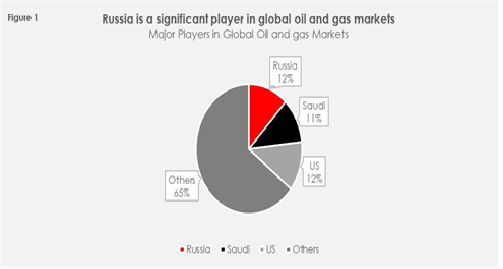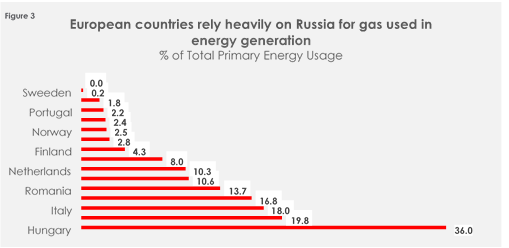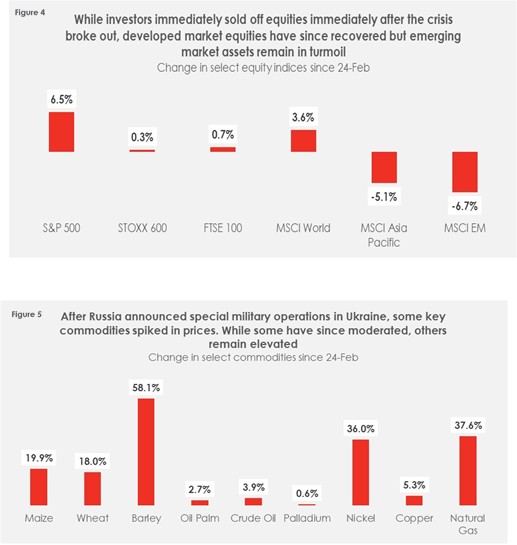By United Capital Research
On 24th February, Russian President Vladimir Putin ordered a “special military operation” in Ukraine. Following Russia’s invasion of Ukraine, western allies of Ukraine have moved to aggressively punish Russia by imposing economic-destructive sanctions to isolate the Russian economy. Sanctions imposed include freezing Russian central bank assets and significant state-owned banks’ assets abroad, partial access restriction to the international payments system SWIFT, a hold on the Germany-Russian gas pipeline project, and a ban on Russian oil and non-oil products in the U.S market, among others. However, the responses from western allies have stopped short of direct military interventions against Russia as it seeks to avoid a direct altercation that could spark a world war. Both parties have made several peace talks and ceasefire negotiations; however, the possibility of a diplomatic resolution is far from possible in the near term. Thus, we seek to evaluate the impact of a prolonged war on the global economy, domestic economy, trade, commodities, and financial markets.
Global Economy: Disruption to growth momentum amid elevated inflation
The current crisis will have substantial long-term effects on global supply chains and trade dimensions for years to come. Supply chains are likely to remain clogged as disruptions in shipments, shortage of containers, and logistical difficulties in acquiring raw materials will likely negatively impact output growth across the globe. Similarly, rising energy and food prices will derail the largely positive global economic momentum after pandemic-induced disruptions in the last 24 months. That said, we believe calls of a global recession may be a far cry as we expect the impacts of the Russo-Ukraine crisis will be felt to different degrees for different industries. For example, energy-sensitive and steel-sensitive industries will likely face severe effects from input shortages and elevated cost pressures. For context, the Organisation for Economic Co-operation and Development (OECD) projects global economic growth for 2022 to be 0.95ppt – 1.0ppt lower than the start of the year projections. Also, the National Institute of Economic and Social Research (NIESR) projects that 2022 economic growth will be lower than the start of the year projections by 0.5ppt. Thus, we can establish that while the crisis is likely to slow the momentum of global growth, the global economy is not expected to face a recession, except the crisis degenerates into a world war.
Beyond economic growth, the crisis is poised to have far-reaching consequences for inflation. Russia and Ukraine are critical exporters of commodities like Oil, Gas, Wheat, Corn, Palladium, Nickel, Aluminum etc., many of which are used in the production of several durable and consumption goods. The impact of sanctions on Russian exports and unwillingness to buy Russian produce would create a surge in demand for non-Russian counterparts. Also, operational disruptions at key ports for Ukraine and the inability to conduct economic activities would reduce supply from Ukraine. Consequently, consumers across the globe would face higher energy costs and broad-based inflation.
The NIESR estimates the crisis will add 3.0ppts to global inflation for 2022 and about 2.0ppts for 2023. On the other hand, the OECD’s estimates are milder, with a projection that global inflation will be higher by 1.6ppts – 1.75ppts in 2022.
Due to weaker growth and higher inflation, consumers are set for a torrid period as the cost of living is expected to jump due to higher energy costs, elevated food prices.
According to USDA, in 2020, U.S. consumers spent 8.6% of their disposable personal income on food. In the EU, the average household spent almost 6.4% of their total expenditure on energy products in 2018. In 2019, households in the EU spent 6.8% of EU GDP on food and non-alcoholic beverages. The war in Ukraine and the sanctions against Russia have created a new supply shock that will continue to push prices higher.
Following the Russian-Ukraine crisis, market players and investors have begun to ponder the interest rate decisions of major central banks. In 2022, our expectations were for aggressive monetary tightening following accommodative stances adopted by major central banks in 2020 and 2021. The Russian-Ukraine crisis has now put monetary authorities on increased alert. The recent sanctions on Russia will lead to spikes in fuel, transport, and commodities prices, spooking further inflationary pressures, curbing average global household purchasing power and disrupting economic growth momentum. To calibrate appropriate responses, monetary authorities will need to carefully monitor the pass-through impact of rising international prices on domestic inflation. Unless the war degenerates into a world war, the global economy will likely remain on the growth path while the labour market is expected to remain tight. This will probably give monetary authorities some wriggle room in calibrating policy decisions.
Overall, while there is a consensus that although the recent cycle would not alter a Fed rate hike in 2022, the crisis and the potential effect on household income would change the aggressiveness of the Fed’s hawkish actions. As we advance, we expect major central banks in developed countries to continue the path of policy tightening as it hopes to tackle inflationary pressures. However, we believe policymakers will keep global growth momentum in view to ensure policy tightening does not contribute to derailing the recent economic recovery, possibly curtailing previously anticipated aggressiveness.
Interestingly, at the March monetary policy meetings, the US Fed and the Bank of England (BoE) raised benchmark interest rates by 25bps, indicating the likelihood of sustained policy tightening despite mounting uncertainties and disruptions to global growth. Fiscal policy will need to support the most vulnerable households to help offset rising living costs. This crisis will create complex policy tradeoffs, further complicating the policy landscape as the world economy recovers from the pandemic crisis. On the fiscal side, we do not expect any broad-based fiscal support or helicopter money as we saw at unprecedented levels during the pandemic. However, we cannot rule out the possibility of some government support for the lowest-earning households to reduce the impacts of higher energy, consumables, and housing costs. For emerging and lower-income economies that may have already reached the cap of their fiscal support, we expect the crisis to deepen the fiscal imbalance and poverty numbers in the region.
Commodities prices: Differing degree of impacts
The Russo-Ukraine crisis has had a significant impact on the commodities market, given they are both heavy producers of some energy, agricultural and metal commodities.
Investors expect the conflict to impact the supply chains of some essential products, including Energy, Wheat, and metal-related commodities. In addition, the sanctions implemented by western allies and retaliation from Russia are expected to have a devastating impact on the supply of those commodities. For context, the UK and the US have recently announced sanctions on exports of Russia in the last three weeks. Russia has also followed up with sanctions, halting all exports to 48 “hostile countries”.
The question of Russia and Ukraine’s contribution to global trade is critical to establish as it would determine the extent of the impact on commodities prices. Data from the United Nations Conference on Trade and Development (UNCTAD) shows that Russia and Ukraine are insignificant contributors to global aggregate trade. According to UNCTAD data, Russia contributes 1.9% of global trade while Ukraine contributes 0.3%. Thus, supply shocks in the commodities market caused by the crisis are not likely to be as broad-based as initially feared. While Russia and Ukraine have an insignificant contribution to global trade, they are among the top exporters of some essential commodities (such as crude oil, gas, wheat, corn, and metal-based commodities). For example, Russia is the world’s 3rd oil producer and the 2nd largest crude oil exporter behind Saudi Arabia. In Jan-22, Russia’s total oil production was 11.3 mb/d. By comparison, US total oil production was 17.6 mb/d while Saudi Arabia produced 12.0 mb/d. Thus, we expect the energy, steel, and to some degree, the commodities market’s agriculture (wheat & corn) segment would be the most impacted by the Russo-Ukraine crisis.

As part of sanctions on Russia, the US announced a ban on all Russian oil, gas, and coal imports. Also, the UK joined in announcing a gradual phase-out of Russian oil imports over the next year. In response to the announcement, crude prices jumped to multi-year highs of $133.0/bbl but have since trended lower. Unsurprisingly, other Western allies have been unwilling to participate in sanctions on Russian energy exports. The US and the UK are not significant buyers of Russian energy exports. Cutting through historical data from the International Energy Agency (IEA) on Russian energy trade, 60.0% of Russian oil exports go to OECD Europe. China (the most significant single buyer of Russian energy) buys c.20.0% of Russian crude exports. Thus, it becomes clear why other western allies in Europe were unwilling to participate in the sanctions, given the ripple impact on energy costs.

Overall, we expect the impact of these sanctions to be broadly muted on the oil market in the long run. The most significant impact could come from European oil traders ignoring Russian oil in solidarity with Ukraine, creating considerable demand for non-Russian oil & gas and higher energy prices. Also, should Europe decide to go all in to ban Russian energy exports, then we could consequently see a significant uptick in oil prices. Moving away from energy, Russia and Ukraine export about 29% of the world’s wheat (Russia – 18.0%, Ukraine – 11.0%). Ukraine is the third-largest exporter of corn and a top exporter of barley and rye, making the impact of this crisis especially harsh on food markets, which could lead to accelerating inflationary pressures in developed markets. A handful of economies in Europe and Central Asia, the Middle East, and Africa are particularly vulnerable to a disruption in the production or transportation of grains and seeds from Russia and Ukraine. For lower-income countries, disruption to supplies and higher prices could cause increased hunger, food insecurity and food inflation.

Regarding metals and other irons, Russia produces 6.0% of the world’s aluminium, platinum, and nickel, a significant component crucial to car production and a key ingredient in electric car batteries, both of which are trading at levels not seen in more than a decade. Russia also produces roughly 40.0% of the world’s palladium. A market hit with supply-side constraints since the pandemic. Russia’s special military operation will cause increased shortages in the semiconductor and chip market, which has battled supply-side constraints since the pandemic in 2020.
Global financial markets: Elevated risks and divergent outlook
The global financial market panicked after Russia invaded Ukraine, leading to significant selloffs across equities while safe havens like US Treasuries and Gold rallied. For context, the MSCI World index lost 3.8%, while country and region-specific indices like the FTSE 100, S&P 500, and STOXX 600 lost 7.1%, 1.3% and 8.6%, respectively, in the first two weeks of the crisis. Similarly, the Russian equities market suffered a significant plunge as the benchmark RTS index lost 38.3% on the first day of the crisis. In addition, we saw an upsurge in some commodities, which traders speculated could see shortages due to the crisis. Commodities like Wheat (+45.3%), Palladium (+21.5%), Nickel (94.5%), and Maize (+30.2%) all rallied in the first two weeks of the invasion.
Nevertheless, as investors garnered clarity and insights into the likely effects of the crisis, we saw some recovery across developed market instruments, clawing back losses. This is reflected in the positive return across the S&P 500, STOXX 600 (+0.3%), FTSE 100 (+0.7%) and the MSCI World index (+3.6%) since the turn of the crisis. Meanwhile, gains in some commodities that rallied early on during the invasion have since moderated. Despite the seeming calm, emerging market assets have not been spared from selloffs. We note that uncertainties created by the policy normalisation narrative only fueled investors’ concerns around the Russian invasion, leading to investors pulling out their funds from these assets. For example, the MSCI EM Index is still down 6.7% since the start of the invasion.

Unless the regional war degenerates into a world war, we will likely see a muted effect on developed financial market assets. We believe Russia’s ability to wreak economic havoc on these advanced economies is limited, saving for energy dependence. Thus, if the economic recovery narrative is sustained, corporate profitability will likely remain upbeat.
Nevertheless, we note that investors continue to look over their shoulders as they monitor developments around the Eastern Europe crisis. In addition, the hawkish policy signal from the US Fed is a critical concern for investors. Thus, unless corporate profitability performance proves to be overwhelmingly positive, we expect developed market equities to remain downbeat as investors’ appetite for risk assets may remain weak.
The conflict has already caused tremors in these financial markets for emerging and frontier markets, prompting selloffs in emerging market financial assets. High investor risk aversion could lead to capital outflows from developing economies, triggering currency depreciation, falling stock prices, and higher risk premiums in bond markets. This raises the probability of acute stress for the dozens of developing economies with high debt levels.
Economies with high current account deficits or a large share of short-term debt denominated in foreign currencies would struggle to roll over the debt. Alternatively, they could face higher debt service obligations.
Implications for Nigeria
Macroeconomic Impact: Inflation and fiscal imbalance are major concerns Nigeria appears to be one of several countries likely to feel the minimal impact of the crisis on economic activities. The biggest concern for Nigeria will be the impact of the crisis on inflation, trade balance, Fiscal balance, and FX liquidity. The implications for economic growth for 2022 are likely to be muted or marginal at most. Although higher energy prices could be a key concern for the manufacturing sector while higher inflation could weaken consumer purchasing power, we expect key growth drivers (Agriculture & Services) to remain upbeat amidst the crisis. Thus, we retain our GDP forecast of 2.1% for 2022.
We note that Nigerians should be set for another year of unabating an uptick in prices. First, energy prices are projected to be higher if the crude oil price remains at elevated levels (above $90.0/bbl). However, the impact on energy cost is likely to be moderate as petrol prices remain regulated with fuel subsidies still in place. The effect will be mainly on diesel prices, gas prices and other energy sources. In addition to energy cost we are likely to see the impact on food prices over the next couple of months. Prices of raw agricultural inputs like Wheat, Barley, and Corn are expected to sustain the uptrend, which would impact the prices of items like flour (and consequently pastries, bread etc.), fertilisers etc. Lastly, we expect to see the pass-through impact of imported inflation given the sizeable portion of imported goods consumed in Nigeria.
Another significant implication for Nigeria is the economy’s trade balance and the consequent impact on foreign exchange. The surge in global price level and higher cost of importing petroleum products will likely drive upward pressure on the nation’s import bill. The higher crude oil price environment is a positive for Nigeria as it would support increased earnings from crude oil exports. However, that is likely to be capped by suboptimal production levels caused by unabating oil theft. Overall, we expect the net impact to be a case of sustained trade deficit with the possibility of a wider deficit relative to 2021. This would have a negative ripple effect on FX liquidity and pricing. We expect this to prolong the nation’s FX shortage, particularly given expectations of weaker official inflows into the capital account. This reinforces the possibility of a devaluation but may be put on hold till post-2023 general elections, given political interests.
FG’s fiscal balance is likely to face the most considerable adverse effect of the Russia-Ukraine crisis. The elevated cost of importing petroleum products continues to drive the price of subsiding petrol higher. The government insists on running its PMS and electricity subsidy programs to make these goods and services more accessible and affordable to the public. As a result of the subsidy payments and sub-optimal crude oil production level, the Nigerian National Petroleum Company (NNPC) has struggled to remit revenues into the Federation Account. This has created significant revenue pressures for the federal government. The prolonged period of high crude oil prices is a significant concern going forward as it implies the NNPC may be unable to remit revenues into the FG’s coffers. This would further worsen the FG’s fiscal imbalance. We also see a scenario that leads to elevated naira rates as the FG aggressively sources debt funding to plug gaping holes in the debt market in Q2-2022. Interestingly, the President has sent a request to the National Assembly to approve additional borrowing plans and increase the budget deficit due to changes in economic conditions.
Heading into 2022, we projected that monetary policymakers across emerging and frontier markets would hold a tightening bias on monetary policy as the policy normalisation narrative in developed economies was expected to garner pace. This expectation has proved true across several emerging economies, with Nigeria being a major difference. Nigeria’s monetary policymakers have shown an unwillingness to hike its benchmark interest rate as it views inflationary pressures as structurally driven. At the same time, it reckons that capital flight would not be a challenge for Nigeria as foreign investors have a very much reduced presence in Nigeria. Overall, the committee’s key focus has been economic growth via development finance initiatives and, to a lesser extent, exchange rate stability. However, we expect the committee’s resolve will be tested by the more substantial inflationary pressures expected in the coming months. We expect to see at least one rate hike before the end of the year to combat inflationary pressures.
Equity market: Differing impacts across sectors
The impact of the Russian-Ukraine crisis is likely to have diverging effects on listed companies in the domestic equities market. In the Upstream Oil and gas segment of the market, elevated oil prices due to sanctions would increase margins for listed upstream stocks. On the other hand, manufacturing and some FMCG firms will face operating cost constraints due to increased energy costs. Below we discuss some of the sectors likely to be affected and the direction of such impact:
Oil and Gas sector: Although production constraints will remain a significant concern for the Oil and Gas sector, increased prices will continue to bolster margins and profitability, especially for firms listed in the upstream Oil and Gas segment. The potential acquisition of other NNPC JVS also means that the potential sale of assets and takeover effects also boost the valuation of our upstream listed companies. In a more probabilistic scenario, resolving issues around oil theft would enable Nigeria’s oil & gas companies to fill potential production gaps resulting from sanctions on Russian oil & gas. For the downstream sector, the crisis’s impact is likely to be muted as the price and profit margin of petrol (which contributes the most significant chunk of revenue) remain fixed while the FG bears higher costs. The biggest concern will be the ability to sustain supply to the market as the NNPC (the sole importer of petrol) struggles to import expensive petroleum products.
FMCG sector: In recent years, FMCG companies in Nigeria have had to combat exchange rate and inflationary pressures, impacting the cost of production and subsequently eroding margins and profitability (worsened by slow volume growth). The Russia-Ukraine crisis is only likely to worsen cost concerns for these businesses. First, the price of key raw materials (such as Wheat, Corn, LAB etc.) has increased sharply since the crisis began. Even though energy cost has been on the rise in tandem with other costs, the crisis will likely force a sharper increase following the steep rally in oil prices. Thus, we expect the impact of the crisis would be harmful as it implies FMCG firms are likely to face mainly increased cost pressures in the coming quarters.
Cement and Industrial industry: We expect the Cement Industry to face significant cost pressures as a direct consequence of the crisis. While the impact across companies will be divergent, depending on the production energy mix, we expect all cement companies within our coverage will face decent upward pressure on production cost because of mounting energy cost inflation. We believe that the oligopolistic nature of the industry, which sees the top three companies control c.98.0% of the industry’s volume, will give players sufficient pricing power to transfer added cost pressures to consumers.
Analyst: Team coverage research@unitedcapitalplcgroup.com








